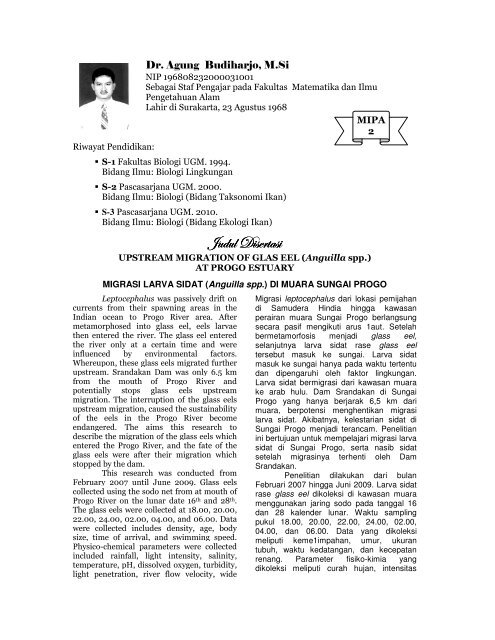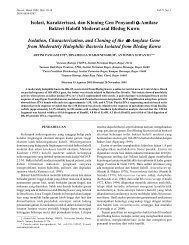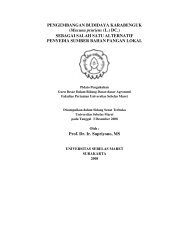Migrasi Larva Sidat - Data Informasi UNS
Migrasi Larva Sidat - Data Informasi UNS
Migrasi Larva Sidat - Data Informasi UNS
You also want an ePaper? Increase the reach of your titles
YUMPU automatically turns print PDFs into web optimized ePapers that Google loves.
Riwayat Pendidikan:<br />
Dr. Agung Budiharjo, M.Si<br />
NIP 196808232000031001<br />
Sebagai Staf Pengajar pada Fakultas Matematika dan Ilmu<br />
Pengetahuan Alam<br />
Lahir di Surakarta, 23 Agustus 1968<br />
MIPA<br />
2<br />
� S-1 Fakultas Biologi UGM. 1994.<br />
Bidang Ilmu: Biologi Lingkungan<br />
� S-2 Pascasarjana UGM. 2000.<br />
Bidang Ilmu: Biologi (Bidang Taksonomi Ikan)<br />
� S-3 Pascasarjana UGM. 2010.<br />
Bidang Ilmu: Biologi (Bidang Ekologi Ikan)<br />
]âwâÄ ]âwâÄ W|áxÜàtá|<br />
W|áxÜàtá|<br />
UPSTREAM MIGRATION OF GLAS EEL (Anguilla spp.)<br />
AT PROGO ESTUARY<br />
MIGRASI LARVA SIDAT (Anguilla spp.) DI MUARA SUNGAI PROGO<br />
Leptocephalus was passively drift on<br />
currents from their spawning areas in the<br />
Indian ocean to Progo River area. After<br />
metamorphosed into glass eel, eels larvae<br />
then entered the river. The glass eel entered<br />
the river only at a certain time and were<br />
influenced by environmental factors.<br />
Whereupon, these glass eels migrated further<br />
upstream. Srandakan Dam was only 6.5 km<br />
from the mouth of Progo River and<br />
potentially stops glass eels upstream<br />
migration. The interruption of the glass eels<br />
upstream migration, caused the sustainability<br />
of the eels in the Progo River become<br />
endangered. The aims this research to<br />
describe the migration of the glass eels which<br />
entered the Progo River, and the fate of the<br />
glass eels were after their migration which<br />
stopped by the dam.<br />
This research was conducted from<br />
February 2007 until June 2009. Glass eels<br />
collected using the sodo net from at mouth of<br />
Progo River on the lunar date 16 th and 28 th .<br />
The glass eels were collected at 18.00, 20.00,<br />
22.00, 24.00, 02.00, 04.00, and 06.00. <strong>Data</strong><br />
were collected includes density, age, body<br />
size, time of arrival, and swimming speed.<br />
Physico-chemical parameters were collected<br />
included rainfall, light intensity, salinity,<br />
temperature, pH, dissolved oxygen, turbidity,<br />
light penetration, river flow velocity, wide<br />
<strong>Migrasi</strong> leptocephalus dari lokasi pemijahan<br />
di Samudera Hindia hingga kawasan<br />
perairan muara Sungai Progo berlangsung<br />
secara pasif mengikuti arus 1aut. Setelah<br />
bermetamorfosis menjadi glass eel,<br />
selanjutnya larva sidat rase glass eel<br />
tersebut masuk ke sungai. <strong>Larva</strong> sidat<br />
masuk ke sungai hanya pada waktu tertentu<br />
dan dipengaruhi oleh faktor lingkungan.<br />
<strong>Larva</strong> sidat bermigrasi dari kawasan muara<br />
ke arab hulu. Dam Srandakan di Sungai<br />
Progo yang hanya berjarak 6,5 km dari<br />
muara, berpotensi menghentikan migrasi<br />
larva sidat. Akibatnya, kelestarian sidat di<br />
Sungai Progo menjadi terancam. Penelitian<br />
ini bertujuan untuk mempelajari migrasi larva<br />
sidat di Sungai Progo, serta nasib sidat<br />
setelah migrasinya terhenti oleh Dam<br />
Srandakan.<br />
Penelitian dilakukan dari bulan<br />
Februari 2007 hingga Juni 2009. <strong>Larva</strong> sidat<br />
rase glass eel dikoleksi di kawasan muara<br />
menggunakan jaring sodo pada tanggal 16<br />
dan 28 kalender lunar. Waktu sampling<br />
pukul 18.00, 20.00, 22.00, 24.00, 02.00,<br />
04.00, dan 06.00. <strong>Data</strong> yang dikoleksi<br />
meliputi keme1impahan, umur, ukuran<br />
tubuh, waktu kedatangan, dan kecepatan<br />
renang. Parameter fisiko-kimia yang<br />
dikoleksi meliputi curah hujan, intensitas
mouth of the river, water level, and organic<br />
materials. These glass eels were tested on the<br />
swimming speed and the resilience of life in<br />
many different salinities. These glass eels also<br />
were collected from the mouth of the river up<br />
to Srandakan Dam on the lunar date 17 th and<br />
29 th . Yellow eels that collected from the<br />
mouth of Progo river until the dam and also<br />
at the Nepi tributary using the bubu traps.<br />
Glass eel data that collected included body<br />
length, climbing ability of eel ladder, and the<br />
number of individual. Yellow eels that<br />
collected from the dam until headwaters<br />
within 62 km from the estuary were collected<br />
using fishing rods. <strong>Data</strong> analyzed for<br />
descripted to glass eel density, and the fate of<br />
glass eel after their migration were stopped<br />
by the dam. Fluctuations of glass eel density<br />
analyzed based on the trend. Percentage of<br />
yellow eels were migrated into Nepi tributary<br />
analyzed by the CPUE method. The<br />
relationship between age and body size of<br />
glass eels were analyzed by simple one way<br />
ANOVA method. The relationship between<br />
physico-chemical parameters and glass eels<br />
density in the estuary were analyzed by the<br />
PCA method.<br />
In the period of February 2007 - June<br />
2009, the glass eels was collected in mouth of<br />
the Progo River of 1.082 samples, consisting<br />
of A. marmorata (31.42%), A. bicolor bicolor<br />
(63.96%), and A. nebulosa nebulosa (4.62%).<br />
These glass eels ages between 58-190 days,<br />
which were divided into 5 ages groups. These<br />
eels larvae entered the Progo River when sea<br />
currents in the Indian Ocean that leading to<br />
the Progo River carried leptocephalus. The<br />
glass eels migrated into the Progo River only<br />
in the rainy season in the month of October to<br />
June in the year 2007 to 2009. In the<br />
migration period October to January in 2007-<br />
2009, these glass eels entered the river from<br />
the east, and which the result of spawning in<br />
July to October in 2006-2008. In the<br />
migration period February to June in 2007-<br />
2009 which glass eels entered the river from<br />
the west, and which as the result of spawning<br />
in November to January in 2006-2009. The<br />
glass eel migrated only in the month with<br />
rainfall above 125 mm per month, at the end<br />
of the lunar month, and at night when the<br />
light intensity of 0 lux. The peak annual<br />
migration of glass eels in the mouth of the<br />
river were occured at the after preceded by<br />
high rainfall 3-5 months earlier and the river<br />
flow velocity was low. In these conditions,<br />
peak of daily migration were occured at flood<br />
cahaya, salinitas, suhu, pH, kandungan<br />
oksigen terlarut, turbiditas, penetrasi cahaya,<br />
kecepatan arus sungai, 1ebar mulut sungai,<br />
aras permukaan perairan muara, dan<br />
kandungan bahan organik. <strong>Larva</strong> sidat yang<br />
ditangkap diukur kecepatan renang dan diuji<br />
ketahanan hidupnya pada berbagai salinitas<br />
yang berbeda. Glass eel juga dikoleksi di<br />
sungai dari muara hingga dam pada tanggal<br />
17 dan 29 kalender lunar pada pukul 04.00.<br />
<strong>Sidat</strong> rase yellow eel di bawah dam<br />
ditangkap menggunakan perangkap bubu<br />
dari muara hingga dam serta di Kali Nepi.<br />
<strong>Data</strong> yellow eel di bawah dam yang dikoleksi<br />
adalah cacah individu, panjang tubuh, dan<br />
kemampuan memanjat eel ladder. <strong>Sidat</strong> rase<br />
yellow eel di atas dam ditangkap<br />
menggunakan pancing sampai jarak 62 km<br />
dari muara. <strong>Data</strong> diana1isis untuk<br />
mendeskrepsikan dinamika kemelimpahan<br />
larva sidat, serta nasib sidat setelah Dam<br />
Srandakan dibangun. Dinamika<br />
kemelimpahan larva sidat dinalisis<br />
berdasarkan trend yang terjadi. Cacah<br />
individu yellow eel di bawah dam yang<br />
masuk ke Kali Nepi dianalisis dengan<br />
metode CPUE. Hubungan antara umur dan<br />
ukuran tubuh larva sidat dianalisis dengan<br />
metode one way anova sederhana.<br />
Hubungan antara parameter fisiko-kimia<br />
dengan kemelimpahan larva sidat di muara<br />
dianalisis dengan metode PCA.<br />
Dalam kurun waktu Februari 2007 -<br />
Juni 2009 telah dikoleksi sampellarva sidat<br />
di muara Sungai Progo sebanyak 1.082<br />
ekor, yang terdiri ares A. marmorata, A.<br />
bicolor bicolor, dan A. nebulosa nebulosa.<br />
<strong>Larva</strong> sidat jenis A. bicolor bicolor paling<br />
banyak masuk sungai (63,96%). Kisaran<br />
umur larva sidat 58-190 hari, yang dibagi<br />
dalam 5 kelompok umur. <strong>Larva</strong> sidat masuk<br />
ke muara Sungai Progo saat arus laut di<br />
Samudera Hindia yang mengarah ke muara<br />
membawa leptocephalus. Glass eel<br />
bermigrasi masuk ke Sungai Progo hanya<br />
pada musim penghujan di bulan Oktober -<br />
Juni pacta tabun 2007 - 2009. Pada periode<br />
migrasi bulan Oktober - Januari tabun 2007 -<br />
2009 larva sidat datang ke muara dari arab<br />
timur, dan merupakan hasil pemijahan bulan<br />
Juli - Oktober tabun 2006 - 2008. Pada<br />
periode migrasi bulan Februari - Juni tabun<br />
2007 - 2009 larva sidat datang ke muara dari<br />
arab barat, dan merupakan hasil pemijahan<br />
bulan Nopember - Januari tahun 2006 -<br />
2009. <strong>Migrasi</strong> tahunan larva sidat
tide. The glass eels were entered the mouth of<br />
Progo River immediately upstream migration<br />
and can reach Srandakan Dam within 4 days.<br />
Upstream migration of the glass eels to<br />
headwaters were interrupted by high dam<br />
and too near the mouth of river. Most of eels<br />
that trapped by the dam could not continued<br />
upstream migration. A small percentage of<br />
eels that trapped by the dam migrated into<br />
the Nepi tributaries.<br />
The conclusion of this study were: the<br />
species of eels which migrated to the Progo<br />
River were A. marmorata, A. bicolor bicolor,<br />
and A. nebulosa nebulosa. The eels of A.<br />
bicolor bicolor and A. marmorata come into<br />
the estuaries from the west and the east. A.<br />
nebulosa nebulosa come into the estuaries<br />
from the west. Annual migration occured<br />
during the low salinity because the much<br />
water river into the sea a lot in the rainy<br />
season. The peak of annual migration<br />
preceded by high rainfall 3-5 months earlier<br />
and the velocity of the river flow at the mouth<br />
of the river was low. Daily migration occured<br />
at the end of the lunar month in the evening<br />
when the light intensity of 0 lux. Peak daily<br />
migration occured during the flood tide. The<br />
water breaker inhibit the upstream migration<br />
of eels in the mouth of the river, and<br />
Srandakan Dam was stopped the eels<br />
upstream migration.<br />
Keywords: migration, eels, Anguilla, Progo<br />
River, Indian Ocean<br />
berlangsung pada saat curah hujan di atas<br />
125 mm per bulan. Puncak mirasi tahunan<br />
larva sidat ke muara sungai terjadi setelah<br />
didahului curah hujan yang tinggi 3-5 bulan<br />
sebelumnya, dan kecepatan arus di mulut<br />
sungai rendah yaitu kurang dari 0,2 m per<br />
detik. <strong>Migrasi</strong> harian larva sidat berlangsung<br />
di akhir bulan lunar, pada malam hari saat<br />
intensitas cahaya 0 lux. Puncak migrasi<br />
harian berlangsung saat air pasang naik.<br />
<strong>Larva</strong> sidat yang masuk muara Sungai<br />
Progo segera bermigrasi ke arab hulu dan<br />
dapat mencapai Dam Srandakan dalam<br />
waktu 4 hari. <strong>Migrasi</strong> larva sidat rase glass<br />
eel hanya sampai dam. Dam yang tinggi dan<br />
dekat muara sungai menghentikan migrasi<br />
sidat. Sebagian besar sidat yang terjebak<br />
oleh dam tidak bisa melanjutkan migrasi ke<br />
arab hulu. Sebagian kecil sidat yang<br />
migrasinya terhenti oleh dam, bermigrasi<br />
masuk ke Kali Nepi.<br />
Kesimpulan penelitian ini adalah:<br />
jenis sidat yang masuk Sungai Progo adalah<br />
A. marmorata, A. bicolor bicolor, dan A.<br />
nehulosa nehulosa. <strong>Sidat</strong> jenis A. bicolor<br />
bicolor dan A. marmorata datang ke muara<br />
dari arab barat datang dan timur. <strong>Sidat</strong> A.<br />
nebulosa nebulosa datang ke muara dari<br />
arab barat. <strong>Migrasi</strong> tahunan berlangsung<br />
saat salinitas rendah akibat air sungai<br />
banyak masuk ke laut pada musim<br />
penghujan. Puncak migrnsi tahunan<br />
berlangsung setelah didahului curah hujan<br />
yang tinggi 3-5 bulan sebelumnya serta<br />
kecepatan arus sungai di mulut sungai<br />
rendah. <strong>Migrasi</strong> harian berlangsung di akhir<br />
bulan lunar pada malam hari saat intensitas<br />
cahaya 0 lux. Puncak migrasi harian<br />
berlungsung saat air laut pasang naik.<br />
Tanggul pemecah ombak menghambat<br />
migrasi sidat masuk ke muara dan Dam<br />
Srandakan menghentikan migrasi sidat.<br />
Kata kunci: migrasi, sidat, Anguilla, Sungai<br />
Progo, Samudera Hindia





